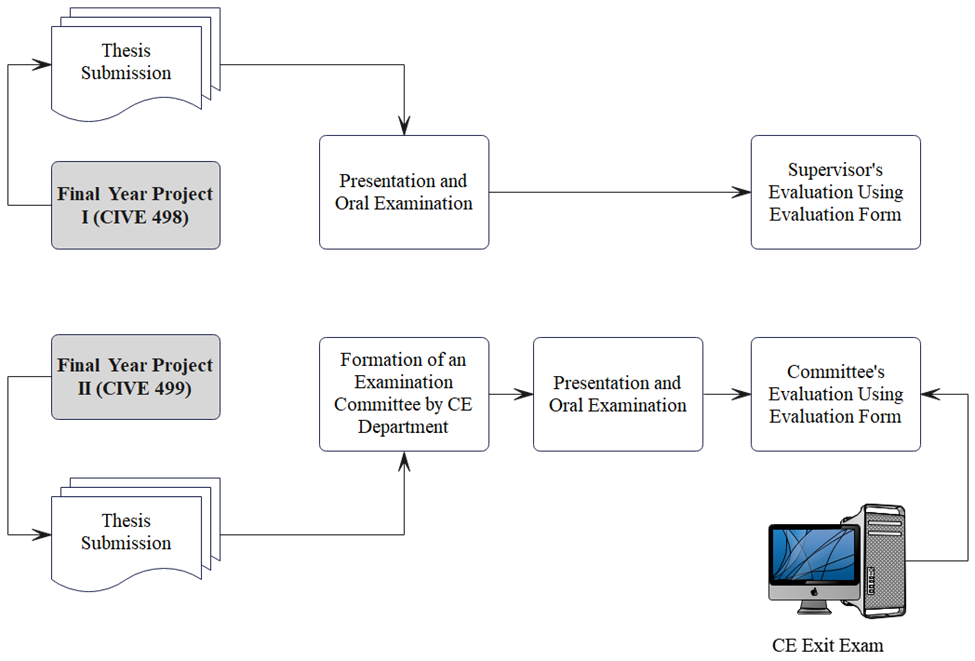Mission
The mission of the Civil Engineering Program is to provide high-quality education anchored in engineering fundamentals together with modern engineering tools to prepare highly competent professionals of high caliber, technical skills, and ethical values to serve the society and nation. We aim to develop visionary leaders and graduate school students who contribute to sustainable development, economic prosperity, and societal progress in Saudi Arabia and beyond. Our program fosters innovation, global awareness, and civic responsibility, empowering students to tackle complex challenges and drive regional growth while serving humanity with integrity and excellence.
Objectives
The Program Educational Objectives (PEOs) of the Civil Engineering program are as follows :
▪PEO-1. Graduates will demonstrate technical proficiency and knowledge to innovatively address societal and professional challenges.
▪PEO-2. Graduates will pioneer and develop safe, ethical, sustainable, and resilient engineering solutions.
▪PEO-3. Graduates will demonstrate professional competence through effective communication, teamwork, ethical conduct, mentorship, and leadership.
▪PEO-4. Graduates will improve their professional competencies through lifelong learning, adaptation to evolving practices, and pursuit of professional licensure, advanced degrees and certifications.
Latest revision of PEOs: Oct. 19, 2025
Learning Outcomes
ABET Student Outcomes (SOs) and their Performance Indicators (PIs) and Mapping with NCAAA PLOs and PEOs
|
ABET SOs |
PIs |
NCAAA PLOs |
PEOs |
|
1) an ability to identify, formulate, and solve complex engineering problems by applying principles of engineering, science, and mathematics. |
1a) Demonstrate the ability to identify and understand the principles of engineering, science, and mathematics. |
K1) Gain knowledge of mathematics, science, and engineering. |
PEO1 |
|
1b) Formulate complex engineering problems by applying the principles of engineering, science, and mathematics. |
K2) Outline engineering problems solutions based on the principles of physical sciences and mathematics. |
PEO1 |
|
|
1c) Apply engineering, science, and mathematics principles to develop solutions for complex engineering problems. |
S1) Solve engineering problems by applying principles of mathematics, science, and engineering. |
PEO1 |
|
|
2) an ability to apply engineering design to produce solutions that meet specified needs with consideration of public health, safety, and welfare, as well as global, cultural, social, environmental, and economic factors. |
2a. Synthesize and apply engineering principles to develop a detailed design solution that explicitly integrates considerations for public health, safety, and welfare, and justifies the design choices based on established criteria and constraints. |
S3) Apply modern techniques and skills to produce solutions in global, economic, environmental, and societal contexts for engineering practice. |
PEO2 |
|
2b. Analyze the potential global, cultural, social, and environmental impacts of the proposed engineering solution, and recommend specific modifications or mitigation strategies to address identified negative consequences. |
PEO2 |
||
|
3) an ability to communicate effectively with a range of audiences. |
3. Communicate effectively with diverse audiences, tailoring the message to the audience's level of understanding and context. |
S5) Communicate effectively with a range of audiences. |
PEO3 |
|
4) an ability to recognize ethical and professional responsibilities in engineering situations and make informed judgments, which must consider the impact of engineering solutions in global, economic, environmental, and societal contexts. |
4a. Recognize and uphold ethical and professional responsibilities in engineering situations. |
V1) Uphold ethical and professional responsibilities. |
PEO2 |
|
PEO3 |
|||
|
4b. Identify alternative engineering solutions, considering economic, environmental, and societal impacts, and address design conflicts. |
S3) Apply modern techniques and skills to produce solutions in global, economic, environmental, and societal contexts for engineering practice. |
PEO2 |
|
|
5) an ability to function effectively on a team whose members together provide leadership, create a collaborative and inclusive environment, establish goals, plan tasks, and meet objectives. |
5a. Identify and fulfill roles within a team to ensure success, integrate inputs from all team members, and make decisions based on objective criteria. |
V2) Function and contribute effectively in a team. |
PEO3 |
|
5b. Monitor team progress and provide constructive feedback to enhance team performance. |
PEO3 |
||
|
6) an ability to develop and conduct appropriate experimentation, analyze and interpret data, and use engineering judgment to draw conclusions. |
6a. Demonstrate good laboratory practices and instrumentation skills to measure specific quantities and collect required data. |
S2) Develop and conduct appropriate experimentation, analyze and interpret data, and use engineering judgement to draw conclusions. |
PEO1 |
|
6b. Use appropriate tools to analyze data, verify and validate experimental results, and account for experimental errors. |
PEO1 |
||
|
7) an ability to acquire and apply new knowledge as needed, using appropriate learning strategies. |
7. Show awareness of the importance of continuous learning and research after graduation, and independently find information relevant to problem-solving. |
K3) Describe and categorize engineering related contemporary issues. |
PEO4 |
|
S4) Acquire life-long learning skills as needed, using appropriate learning strategies. |
PEOs-PIs-NCAAA PLOs Mapping
|
PEOs |
PIs |
NCAAA PLOs |
|
PEO-1: Graduates will demonstrate technical proficiency and knowledge to innovatively address societal and professional challenges |
1a, 1b, 1c, 6a, and 6b |
K1, K2, S1, and S2 |
|
PEO-2: Graduates will pioneer and develop safe, ethical, sustainable, and resilient engineering solutions. |
2a, 2b, 4a, and 4b |
S3 and V1 |
|
PEO-3: Graduates will demonstrate professional competence through effective communication, teamwork, ethical conduct, mentorship, and leadership. |
3, 4a, 5a, and 5b |
S5, V1 and V2 |
|
PEO-4: Graduates will improve their professional competencies through lifelong learning, adaptation to evolving practices, and pursuit of professional licensure, advanced degrees and certifications. |
7 |
K3 and S4 |
Curriculum and Program Structure
The curriculum is designed in conformance with the study plan approved by the MOE. It includes courses in basic sciences and mathematics, engineering sciences, engineering design, communication skills, and humanities and social sciences. Lab hands-on experience and emphasis on design are important elements that are integrated throughout the curriculum.
The requirements of the BCE include:
▪ 35 credit hours of mathematics and basic sciences,
▪ 87 credit hours of engineering sciences and engineering design,
▪ 13 credit hours of social sciences and humanities
▪ 15 credit hours of English language and technical writing courses
▪ 9 credit hours in Computer and Programming
The curriculum is designed to grant students the bachelor’s degree upon the successful completion of the fifth-year program. The first year is shared with all engineering majors in order to allow students to transfer from one major to another without losing any credits earned in the first year.
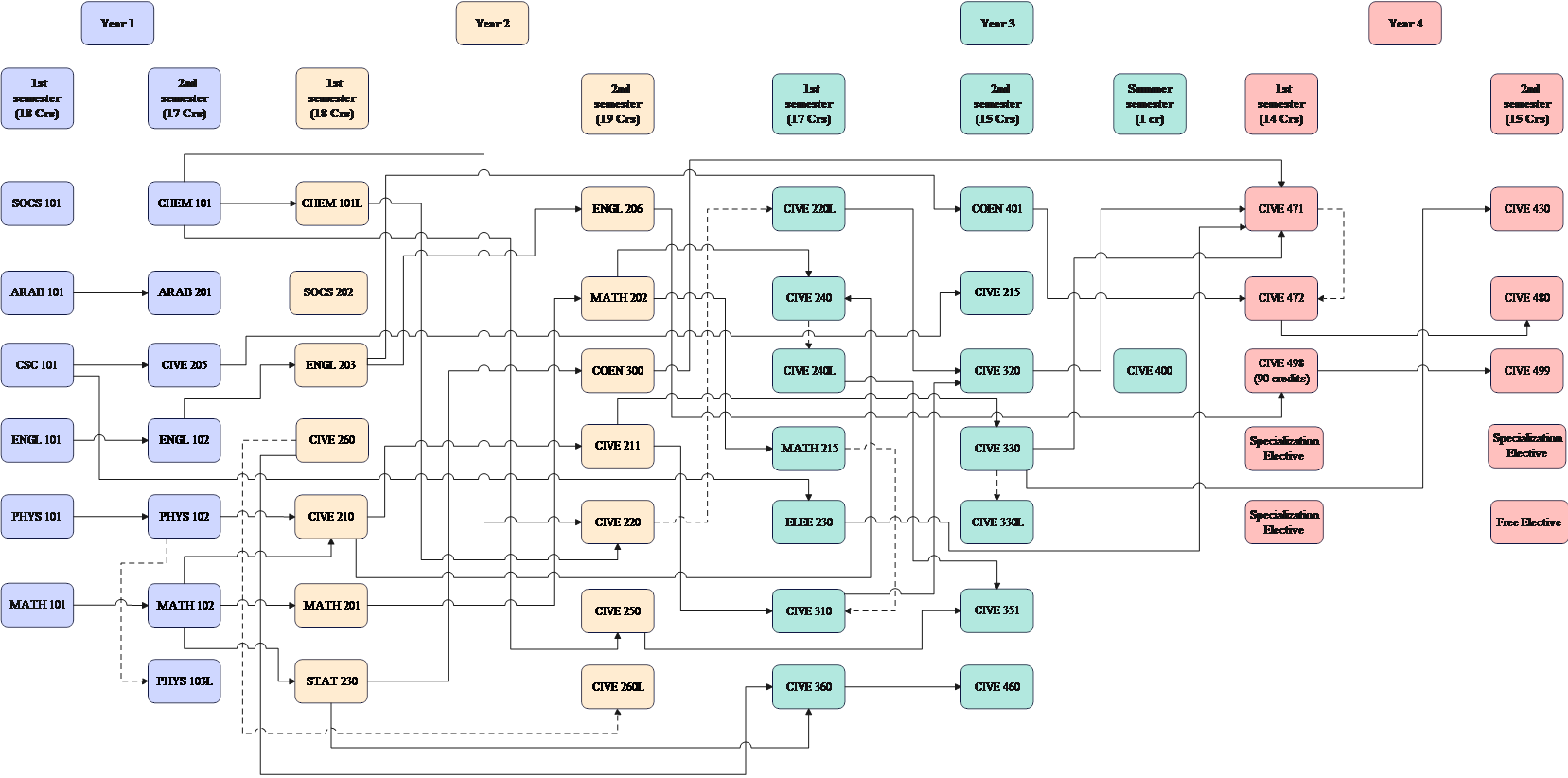
Flowchart illustrating the prerequisite structure of the CE required courses 2019 curriculum (dashed lines denote co-prerequisite)
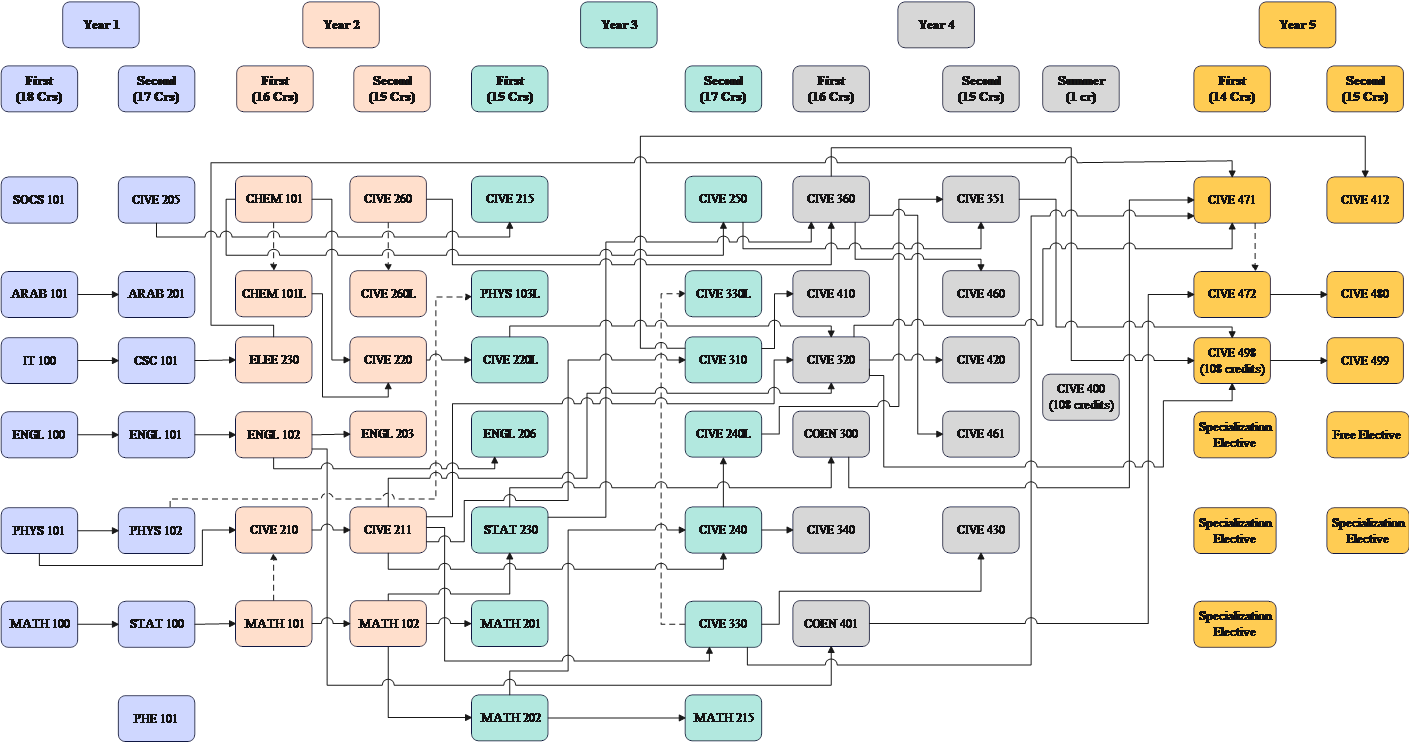
Flowchart illustrating the prerequisite structure of the CE required courses 2023 curriculum (dashed lines denote co-prerequisite)
Career Opportunities
There are numerous jobs that relate directly to holders of Bachelor Degree in Civil Engineering. These include:
- Structural engineers: primarily concerned with designing and constructing buildings and structures that are safe and capable of withstanding the elements to which they will be exposed, as well as improving the structural integrity of existing buildings.
- Transportation and Traffic Engineers: designing, assessing, and managing transportation systems, such as roads, highways, and transit. Designing and implementing traffic management solutions to ensure the safe and efficient flow of vehicles and pedestrians.
- Geotechnical Engineers: geotechnical engineer is responsible for the study and review of the natural environment before a construction project takes place. This includes reviewing the surrounding minerals and materials and helping to design projects based on field and laboratory investigations.
- Environmental Engineers: environmental engineers use the principles of engineering, soil science, biology, and chemistry to develop solutions to environmental problems.
- Water Resources Engineers: are responsible for managing, designing, and implementing projects related to water resources. They play an important role, working on tasks such as assessing water availability, developing water supply and distribution systems, designing water treatment and wastewater management facilities, implementing flood control measures, and addressing environmental concerns related to water.
- Surveying Engineers or Surveyors: surveyors measure and note property boundaries and locations to determine project site specifications.
- Constructions Project Management: plan and coordinate a project from start to finish, including organizing the work schedule, costings and budget, and oversee the buying of necessary materials and equipment.
Degree Requirements
To graduate with a bachelor’s degree in civil engineering (BCE), students must satisfactorily complete 159 credit hours. The distribution of courses in the proposed study plan is as follows:
Students working towards the bachelor’s degree in civil engineering must complete a total of 37 credit hours in University requirements, which are detailed as follows:
▪ 6 credit hours of Arabic: ARAB 101 and ARAB 201;
▪ 15 credit hours of English communication skills: ENGL 100,ENGL 101, ENGL 102, ENGL 203, and ENGL 206;
▪ 7 credit hours of social and cultural studies: SOCS 101, PHE 101, and afree elective course;
▪ 3 credit hours of computing for engineers: IT 100; and
▪ 6 credit hours of mathematics: MATH 100 and STAT 100.
College Requirements
The College of Engineering requirements for the bachelor’s degree in civil engineering include 40 credit hours detailed as follows:
▪ 11 credit hours in sciences: PHYS 101, PHYS 102, PHYS 103L, and CHEM 101/ 101L;
▪ 18 credit hours in mathematics and statistics: MATH 101, MATH 102, MATH 201, MATH 202, MATH 215,and STAT 230;
▪ 6 credit hours in Engineering Programming: CSC 101 and ELEE 230;
▪ 1 credit hour in Engineering Drawings: CIVE 205;
▪ 3 credit hours in Engineering Economy: COEN 300;
▪ 1 credit hour in Engineering Ethics: COEN 401.
Program Requirements
Program specialization requirements consist of 82 credit hours: 70 compulsory credit hours, 12 elective credit distributed as follows:
▪ 70 credit hours for the courses: CIVE 215, CIVE 210, CIVE 211, CIVE 220, CIVE 220L, CIVE 240, CIVE 240L, CIVE 250, CIVE 260, CIVE 260L, CIVE 310, CIVE 320, CIVE 330, CIVE 330L, CIVE 340, CIVE 351, CIVE 360, CIVE 400, CIVE 410, CIVE 412, CIVE 420, CIVE 430, CIVE 460, CIVE 461, CIVE 471, CIVE 472, CIVE 480, CIVE 498, CIVE 499
▪ Four electives (12) credit hours from the selected civil Engineering track (general Civil Engineering track and Environmental engineering track);
⁃ General Civil Engineering track:
CIVE 403, CIVE 411, CIVE 421, CIVE 422, CIVE 423,CIVE 431, CIVE 432, CIVE 433, CIVE 434, CIVE 440, CIVE 441, CIVE 443, CIVE 444, CIVE 445, CIVE 446, CIVE 447, CIVE 448, CIVE 450, CIVE 451, CIVE 452, CIVE 453, CIVE 454, CIVE 455, CIVE 456, CIVE 457, CIVE 458, CIVE 462, CIVE 463, CIVE 464,CIVE 465, CIVE 466, CIVE 470
⁃ Environmental Engineering Track:
CIVE 432, CIVE 448, CIVE 450, CIVE 451, CIVE 452,CIVE 454, CIVE 455, CIVE 456, CIVE 457, CIVE 458, CIVE 459
Partnership with NEOM
Neom, Saudi Arabia's massive “smart city” project, in collaboration with Fahad Bin Sultan University, has opened registration and admission for an internal scholarship program allowing students to pursue a bachelor's degree. Candidates are selected based on their qualifications, and the program offers civil engineering career path as part of the Neom mega-project and its operating companies upon completion of their studies. The agreement aims to develop the country's skilled manpower and create many jobs as it aims to support male and female students in the region to contribute to this project.
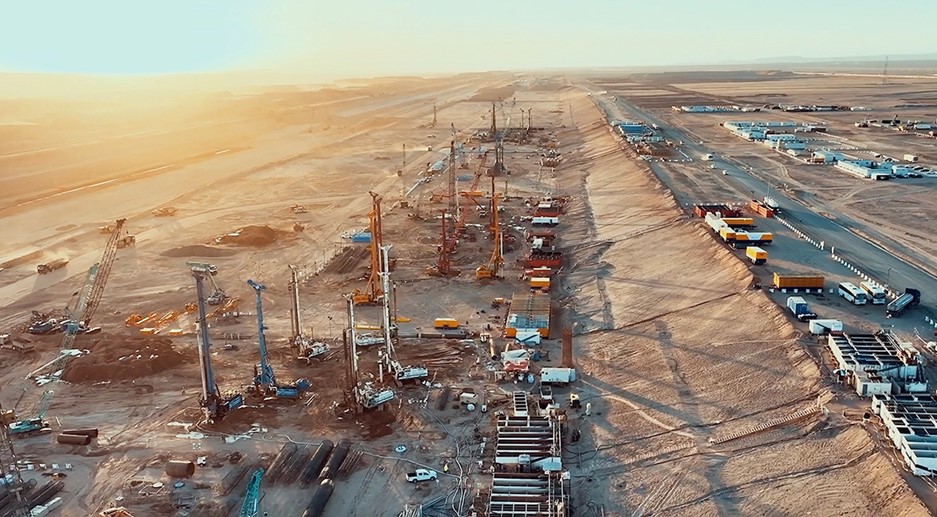
(Source: https://www.neom.com/)
Laboratory Facilities
The laboratories used by the CE program are found in the ground floor of the main building. The CE department is furnished with high quality state-of-art laboratories that support research and teaching activities in the curriculum:
1. Geotechnical Engineering Laboratory is utilized to evaluate the physical, mechanical, and hydraulic properties of soils through a suite of standardized testing procedures. The lab supports analyses such as shear strength evaluation via direct shear and triaxial compression tests, consolidation testing to assess soil settlement under load, and permeability testing to determine hydraulic conductivity. Key index properties, including moisture content (measured via the oven-drying method), specific gravity, and Atterberg limits (liquid limit, plastic limit, and plasticity index) can be conducted in the lab. Grain size distribution analysis, compaction characteristics via Proctor tests (both standard and modified), and in-situ density determination through the sand-cone method are integral to the lab’s capabilities.
2. Engineering Materials Laboratory: The Engineering Materials Laboratory is used for evaluating the properties and performance of construction materials. Key tests include the slump test to assess fresh concrete workability, compressive strength test for determining strength of hardened concrete, and split tensile strength test to measure indirect tensile resistance. The direct tensile strength test evaluates materials under pure tension, while mortar tests analyze consistency, setting time, and strength of cement-based mixtures. Additionally, sieve analysis test determines particle size distribution of aggregates, ensuring proper gradation for optimal material performance.
3. Surveying Laboratory: The tests usually covered include distance measurement by taping and ranging, determining elevations using levelling, horizontal and vertical angles measurement, and total station.
4. Fluid Mechanics Laboratory: The tests usually covered include determination of the friction factor for the pipes, determination of the coefficient of discharge, contraction and velocity of an orifice, verification of Bernoulli’s theorem, determination of critical Reynolds number for a pipe flow, determination of the minor losses due to sudden enlargement, sudden contraction and bends, determination of the velocity distribution in an open channel and to determine the energy and momentum correction factors.
5. Environmental Engineering Laboratory: This is a new lab established to study and analyze various environmental parameters, including water and air quality. The lab is equipped with advanced instruments such as spectrophotometers, dissolved oxygen meters, turbidimeters, and gas chromatographs, to enable students conduct experiments on wastewater treatment, pollution control, and environmental monitoring. The environmental lab helps students testing of biochemical oxygen demand (BOD), chemical oxygen demand (COD), heavy metal contamination, and air pollutant levels.
6. Asphalt Laboratory: This lab equipped with testing facilities, to conduct penetration and viscosity tests for bitumen consistency, dynamic shear rheometer (DSR) to measure viscoelastic properties of bitumen, and Marshall stability tests to determine the strength and deformation resistance of asphalt mixtures. For aggregates, the lab performs analyses, including sieve grading, specific gravity, and abrasion resistance assessments. Additionally, the maximum theoretical specific gravity (Gmm) test is utilized to optimize mixture compaction and void analysis.
Lab Safety Guidelines
The following information is intended to make you better informed; however, before working in the laboratory area, instructors instruct their students in laboratory safety procedures.
- Wearing safety glasses or goggles is mandatory in laboratories where they are needed.
- Be aware of the locations of safety showers, eye washes, fire extinguishers, telephones, and material safety data sheets so you can use them when needed.
- Report all chemical spills immediately to the lab instructor.
- Broken glass and all waste chemicals must be disposed of in the authorized containers.
- Wear lab coats when handling chemicals.
- Always wear shoes in the laboratory, and do not wear sandals or perforated shoes.
- Always wear long pants, and do not wear shorts in the laboratory area.
- If you discover a fire or fire-related emergency such as abnormal heating of material, hazardous gas leaks, hazardous material or flammable liquid spill, smoke, or odor of burning, immediately activate the building fire alarm system and notify the fire department.
- As part of your introduction to the laboratory, before starting experiments in the department labs, students must review the Laboratory Safety Manual with his/her instructor, be familiar with its contents, and keep it handy for reference.
Laboratory Safety Manual.
Final Year Project
As part of their fifth year, students are required to carry out a project and submit a technical report. This project is a substantial piece of work that will require creative activity and original thinking. Students in groups, normally three per group, are supervised while working on a project accounting for four credit hours, extending over a full academic year. The project aims to provide students with a transitional experience from the academic world to the professional world. It is designed to serve as a platform in which CE students in teams engage in a practical design experience requiring the solution of civil engineering design problems.Yet, a student who has already passed a minimum of 90 credits is eligible to register for the Final Year Project.
The objectives of the final year project are:
▪ To allow students to demonstrate a wide range of the skills learned at the College of Engineering during their course of study by asking them to deliver a complete and original design for a Civil Engineering scheme;
▪ To encourage work on multidisciplinary projects, where students get to apply material learned in a number of courses;
▪ To allow students to develop problem solving, analysis, synthesis, evaluation and design skills.
▪ To encourage teamwork;
▪ To improve students' communication skills by asking them to produce both a professional report and a professional poster and to give an oral presentation of their work;
Evaluation process of final year projects
Practical Training
CIVE 400: Internship for CE Students (1 credit hour training non-grade course):
A continuous period of an eight- to twelve-week professional training course in Civil Engineering is spent in a selected work place relating to the field of study. This field internship is intended to provide students with an opportunity to use the knowledge and skills learned in college in an actual work setting. It is intended to be both practical and educational and should include teamwork activities. A final report and training evaluation form will be required at the conclusion of the internship.
Prerequisites by topic: English, Concrete, Transportation (Summer 4th year and 108 credits)
Prerequisites by course: ENGL 206, CIVE 320, CIVE 360
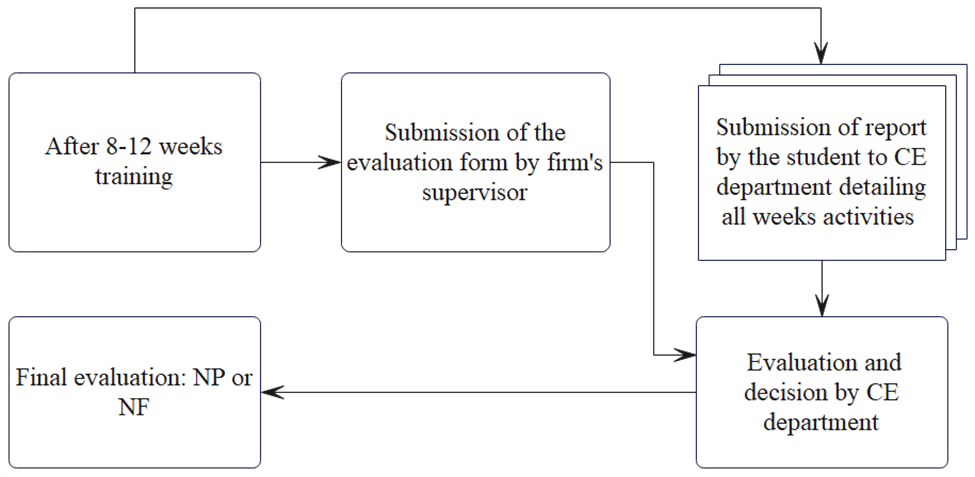
Evaluation process of summer internship training (CIVE 400)
Study Plan
Degree Requirements
To graduate with a bachelor’s degree in civil engineering (BCE), students must satisfactorily complete 159 credit hours. The distribution of courses in the proposed study plan is as follows:
University Requirements
Students working towards the bachelor’s degree in civil engineering must complete a total of 37 credit hours in University requirements, which are detailed as follows:
▪ 6 credit hours of Arabic: ARAB 101 and ARAB 201;
▪ 15 credit hours of English communication skills: ENGL 100, ENGL 101, ENGL 102, ENGL 203, and ENGL 206;
▪ 7 credit hours of social and cultural studies: SOCS 101, PHE 101, and a free elective course;
▪ 3 credit hours of computing for engineers: IT 100; and
▪ 6 credit hours of mathematics: MATH 100 and STAT 100.
College Requirements
The College of Engineering requirements for the bachelor’s degree in civil engineering include 40 credit hours detailed as follows:
▪ 11 credit hours in sciences: PHYS 101, PHYS 102, PHYS 103L, and CHEM 101/ 101L;
▪ 18 credit hours in mathematics and statistics: MATH 101, MATH 102, MATH 201, MATH 202, MATH 215, and STAT 230;
▪ 6 credit hours in Engineering Programming: CSC 101 and ELEE 230;
▪ 1 credit hour in Engineering Drawings: CIVE 205;
▪ 3 credit hours in Engineering Economy: COEN 300; and
▪ 1 credit hour in Engineering Ethics: COEN 401.
Program Requirements
Program specialization requirements consist of 82 credit hours: 70 compulsory credit hours, 12 elective credit distributed as follows:
▪ 70 credit hours for the courses: CIVE 215, CIVE 210, CIVE 211, CIVE 220, CIVE 220L, CIVE 240, CIVE 240L, CIVE 250, CIVE 260, CIVE 260L, CIVE 310, CIVE 320, CIVE 330, CIVE 330L, CIVE 340, CIVE 351, CIVE 360, CIVE 400, CIVE 410, CIVE 412, CIVE 420, CIVE 430, CIVE 460, CIVE 461, CIVE 471, CIVE 472, CIVE 480, CIVE 498, CIVE 499
▪ Four electives (12) credit hours from the selected civil Engineering track (general Civil Engineering track and Environmental engineering track);
▪ General Civil Engineering track:
CIVE 403, CIVE 411, CIVE 421, CIVE 422, CIVE 423, CIVE 431, CIVE 432, CIVE 433, CIVE 434, CIVE 440, CIVE 441, CIVE 443, CIVE 444, CIVE 445, CIVE 446, CIVE 447, CIVE 448, CIVE 450, CIVE 451, CIVE 452, CIVE 453, CIVE 454, CIVE 455, CIVE 456, CIVE 457, CIVE 458, CIVE 462, CIVE 463, CIVE 464, CIVE 465, CIVE 466, CIVE 470
▪ Environmental Engineering Track:
CIVE 432, CIVE 448, CIVE 450, CIVE 451, CIVE 452, CIVE 454, CIVE 455, CIVE 456, CIVE 457, CIVE 458, CIVE 459
Download Current Study Plan
Download Previous Study Plan
Current Study Plan
A typical sequence of courses is shown below:
First Semester
Second Semester
Third Semester
Fourth Semester
Fifth Semester
Sixth Semester
Seventh Semester
Eighth Semester
Summer Semester
Ninth Semester
Tenth Semester
Program Enrollment and Degree Data:
|
Academic Year |
Enrollment Status |
Enrollment Year |
Total Undergrad |
Total Grad |
Degrees Awarded |
||||||||
|
1st |
2nd |
3rd |
4th |
5th |
Associates |
Bachelors |
Masters |
Doctorates |
|||||
|
Current Year |
2025-2026 |
FT |
81 |
93 |
92 |
78 |
0 |
344 |
|
|
|||
|
PT |
- |
- |
- |
- |
- |
- |
|
|
|||||
|
1 |
2024-2025 |
FT |
121 |
91 |
114 |
49 |
0 |
375 |
27 |
10 |
|||
|
PT |
- |
- |
- |
- |
- |
- |
|||||||
|
2 |
2023-2024 |
FT |
131 |
75 |
68 |
36 |
0 |
310 |
57 |
45 |
|||
|
PT |
- |
- |
- |
- |
- |
- |
|||||||
|
3 |
2022-2023 |
FT |
30 |
101 |
44 |
56 |
35 |
266 |
57 |
20 |
|||
|
PT |
- |
- |
- |
- |
- |
- |
|||||||
|
4 |
2021-2022 |
FT |
31 |
42 |
60 |
55 |
50 |
238 |
70 |
29 |
|||
|
PT |
- |
- |
- |
- |
- |
- |
|||||||
|
5 |
2020-2021 |
FT |
23 |
54 |
54 |
82 |
73 |
286 |
127 |
14 |
|||
|
PT |
- |
- |
- |
- |
- |
- |
|||||||
FT--full time
PT--part time
